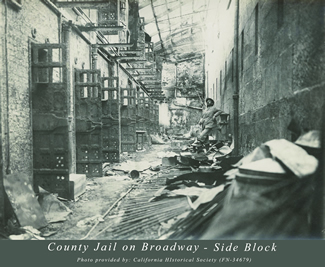
- Guardians Home
- Sheriff Home
- 1906 Earthquake & Fire
- Infamous Inmates
- Roscoe "Fatty" Arbuckle
- Black Bart
- Harry Bridges
- Lenny Bruce
- James Casey
- Fong Ching "Little Pete"
- Jesse Lee Cooks
- Marilyn Chambers
- Charles Cora
- Charles de Young
- Michael de Young
- Frank Egan
- Hallinan Family
- Warren Hinckle
- Billie Holiday
- Gene Krupa
- Tom Mooney
- Richard Ramirez
- Abe Ruef
- Mayor Eugene Schmitz
- Bobby Seale
- Sally Stanford
- Dan White
- Assessor Russell Wolden
- Zebra Killers
- San Francisco Sheriffs
- Chronology
- James Adams
- Eugene A. Brown
- Matthew C. Carberry
- Patrick Connolly
- Peter J. Curtis
- Henry L. Davis
- Thomas Desmond
- Charles Doane
- Lawrence J. Dolan
- Fred S. Eggers
- John S. Ellis
- Thomas F. Finn
- William J. Fitzgerald
- Daniel Gallagher
- William H. Gorham
- John C. Hays
- Michael Hennessey
- Richard D. Hongisto
- Peter Hopkins
- Thomas P. Johnson
- John Lackmann
- Charles S. Laumeister
- Henry S. Martin
- John J. McDade
- William McKibbin
- William McMann
- Daniel C. Murphy
- Matthew Nunan
- Thomas F. O'Neil
- David Scannell
- John Sedgwick
- Richard I. Whelan
- Patrick James White
- Contact Us
- Museum Collections
- Research Request
- Photo Gallery
- Videos
- Donations
| 1906 Great Earthquake & Fire: |
The Strange Journey of San Francisco's Sheriff and His Prisoners After the 1906 Earthquake & Fire By Sheriff Michael Hennessey |
On April 18, 1906, San Francisco held prisoners in three locations: the Hall of Justice at Portsmouth Square, the Broadway jail, both in the city's North Beach neighborhood, and two separate facilities called the Ingleside Jails on the site now occupied by City College. There was also a small holding facility in what was the new City Hall, on Market Street near Larkin, where the San Francisco Public Library is currently located.
San Francisco's first Sheriff, Jack Hays, had built the Broadway jail in 1851. The jail was a two-story affair, sitting on a stone basement. it had 60 twelve-foot long cells, each capable of holding three or four prisoners. The walls were brick. The cell doors were a heavy metal with a small window and a food slot, both of which were typically closed off by hinged metal plates. (2) The Hall of Justice on Kearny Street was one of the newer City buildings, having opened only ten years before in 1896. A jail commonly known as City Prison occupied the top floors of the building. When the massive earthquake stuck at 5:13 a.m., all of San Francisco's jails sustained serious damage. At the small City Hall lockup, the three prisoners, all held on minor offenses, were released immediately. (3) At the Ingleside Jails, the women's facility was damaged so badly that women prisoners were moved to tents set up on the grounds, while the men's facility remained habitable. (4) At the North Beach jails, what the earthquake didn't destroy, fire and dynamite did. Thus began a curious odyssey for the prisoners and their jailers. The early morning earthquake jolted the jails, shook masonry from the walls, and bent cell doorframes, making it difficult to open the cell doors. Speaking of the Hall of Justice, one observer noted, "The building seemed on the verge of collapse, as it creaked and groaned like a worn-out sailing ship in a storm." (5) Prisoner Chuck Connor recalled how prisoners "banged their fists, boots and food bowls against the bars, yelling for help." (6) Another prisoner, Edward Clark, recalled that shortly after the earthquake Judge Cavanaugh arrived with a police escort and ordered the release of those with minor charges. (7) Although the earthquake damaged both the Hall of Justice facility and the Broadway Jail, they remained capable of securely holding the prisoners. In fact, with City Hall in ruins, Mayor Eugene Schmitz made the Hall of Justice his command post for most of April 18th. National Guardsmen and other military personnel were ordered to stand guard outside the two jails to prevent escapes and to prepare for evacuation. By late in the day it was clear that one of the many out of control fires would reach both jails in a matter of hours. Before darkness set in that evening, Mayor Schmitz moved his headquarters again, this time out of the Hall of Justice and up to Nob Hill to the Fairmont Hotel. (8) The Guardsmen were ordered to help evacuate the jails. Guardsman Elmer Enewold wrote to his father about the scene at the Broadway Jail. "It was about 3 a.m. (on April 19th) when the fire had come up within a block of the jail. The official were getting anxious now and were going to turn all the prisoners loose, but our Captain volunteered to take them down to the Military Authorities at Fort Mason. There were about 300 of them against us 60 boys. All the murderers and hard cases were handcuffed to a long chain so they were safe from escape. The others were lined up between us fellows. We were 30 on each side. The order was given to load, fix bayonets and to shoot to kill in case any one of the prisoners attempted to break the line." (9)
Not long after removing the prisoners, both buildings were dynamited as part of a fruitless effort to create a firebreak (13). Both jails were soon engulfed in flames and destroyed completely. Metal supports melted and twisted; cell doors blackened and blistered. The grand cupola on the Hall of Justice survived the earthquake (14), but not the subsequent dynamite and fire. By April 20th, its clock tower was hanging precariously at a ninety-degree angle.
The long line of prisoners guarded by Sheriff's deputies, national Guardsmen, and sailors, made their way through the streets of North Beach toward their destination, Fort Mason. After being loaded on a launch, the detail sailed to San Quentin Prison only to be turned away. Because they had arrived with military escort, Warden John Edgar was not convinced they were state prisoners and refused to accept them. (15) The prisoner ship sailed back to San Francisco, "but as it entered the harbor the thousands of persons who lined the wharves, holding out entreating arms and pleading to be taken aboard and away from the scene of destruction, caused the captain to steam away, finally landing the prisoners at Alcatraz Island." (16) Originally a defensive military fortress, the Alcatraz facility had been converted to a federal military prison in 1861 during the Civil War. The 176 San Francisco prisoners were accepted on an emergency basis at Alcatraz, after almost two days of marching and sailing under guard. (17) Along the way, at least two prisoners hoped the earthquake and fire would work in their favor. The more desperate of the two was local attorney and notorious bigamist George D. Collins, who was already convicted of perjury and sentenced to the maximum sentence of fourteen years in State Prison. Apparently not optimistic of his chances on appeal, Mr. Collins attempted to escape twice during the long evacuation. When the Broadway Jail was emptied out, Collins turned up missing. "A hurried search through the gloomy building on Broadway disclosed him hiding under a cot, where he had chosen to face the approaching flames rather than chance the fortunes of human justice once more." (18) Later, on one of the watery transport, "a number of prisoners were separated from the Sheriff" before custody of all but one was regained. Collins was missing again. Sheriff O'Neil thought it possible that Collins had jumped ship prior to docking. After what is described as " a frenzied hunt," Collins was discovered hiding in a dark ship's closet. (19) While Mr. Collins' journey was far from over, he lost his best chance to escape - and his appeal, which went all the way to the United States Supreme Court - and eventually was received at San Quentin in 1909 after years of legal maneuvering. There he stayed until his release in 1918.
Another prisoner had much better luck, likely due to much better connections. That prisoner was William F. Hopkins, nephew of the late millionaire mark Hopkins. Although serving a ninety-day sentence for assault, within ten days of the earthquake, young Mr. Hopkins was pleased to be released after receiving a pardon signed by California Governor George Pardee. (20) The roundabout journey from Broadway and Portsmouth Square to Alcatraz was not the final stop for the San Francisco prisoners. Beginning on April 26 and continuing for several days, prisoners were ferried on a fireboat called the Governor Irwin from Alcatraz to the Alameda County Jail. The first group of fifty included those with the most serious charges, including three charged with murder. The murder suspects and a few others were shackled together, but with not enough handcuffs to go around, many prisoners were merely "tied together by a long rope coiled about their waists and with a soldier at both ends of the long swaying line." (21) Alameda County Sheriff Frank Barnet is quoted as saying, " We shall be delighted to relieve Alcatraz and although we will be unable to take any more, we shall find room for these. The Alameda County Jail will be filled to its utmost capacity." (22)
For his part, San Francisco Sheriff O'Neil was anxious to get his prisoners back to San Francisco. By April 28, he was proclaiming, "I expect to perfect arrangements before the end of next week for the removal of all of our prisoners now lodged in the Oakland jail back to San Francisco. Things are rapidly settling down to normal conditions on the other side of the bay...We appreciate the kindly courtesy of the Oakland authorities in caring for our group of lawbreakers, and we intend to prove our gratitude by taking them out of Oakland as soon as possible." (23) True to his word, the Sheriff transported the prisoners to the damaged but still functioning Ingleside Jail during the course of the next several months. (24)
The 400-bed Ingleside Jail was opened in 1872. In Sheriff O'Neil's annual report after the earthquake he notes, "This building when built could never have been intended for a jail to hold men of a desperate character, such as was confined in County Jail No. 1 on Broadway Street, as the cells are entirely too small and the floors and ceilings being constructed of wood instead of iron and concrete." By July of 1906, however, the Ingleside Jail had been reinforced considerably, including the addition of a new 120-foot long double fence. A new wood addition for women prisoners was constructed in 1907. (25)
Wen the 1906 earthquake hit, San Francisco was already experiencing an earthquake of a more political nature as the Mayor, the Police Chief and notorious political boss Abe Ruef were all indicted on charges of public corruption. Sheriff O'Neil's close association with Mayor Schmitz and Abe Ruef sealed his fate along with all of the other Union Labor Party candidates. He was easily defeated in his re-election bid in 1907. (28)
The Broadway Jail was never rebuilt. Black Oak Books currently occupies that site. A brass plaque at Romolo Alley fixed to the side of the bookstore building serves as the only reminder of San Francisco's first jail building. The Ingleside Jail continued to serve as San Francisco's largest jail until 1934 when a new jail was opened south of San Francisco, west of the small town of San Bruno. This jail is now the oldest operating jail in California. It is scheduled to be replaced by a new jail in 2006. The Hall of Justice was rebuilt on the Portsmouth Square site, opening in 1912. It remained the booking jail for San Francisco arrestees until 1961, when the current Hall of Justice at 850 Bryant Street was dedicated. The Portsmouth Square site now offers accommodations of a different sort - a Hilton Hotel.
Endnotes: |


 Sheriff Thomas O'Neil, who ran the county jails, had been Sheriff for barely three months. O'Neil was a military veteran, having served as Commander of the California Volunteers in the Spanish-American War. As a candidate, he ran on the Union Labor Party ticket with the incumbent mayor, Eugene Schmitz. Just prior to the earthquake, Sheriff O'Neil had traveled by railroad to San Jose for a meeting with other California Sheriffs. Since the railroads were out of business on April 18th, O'Neil was forced to travel back to San Francisco by automobile at a cost of one hundred dollars. (
Sheriff Thomas O'Neil, who ran the county jails, had been Sheriff for barely three months. O'Neil was a military veteran, having served as Commander of the California Volunteers in the Spanish-American War. As a candidate, he ran on the Union Labor Party ticket with the incumbent mayor, Eugene Schmitz. Just prior to the earthquake, Sheriff O'Neil had traveled by railroad to San Jose for a meeting with other California Sheriffs. Since the railroads were out of business on April 18th, O'Neil was forced to travel back to San Francisco by automobile at a cost of one hundred dollars. (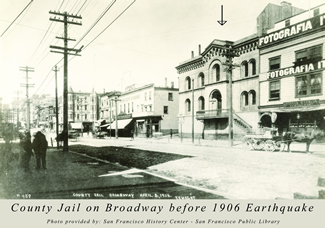
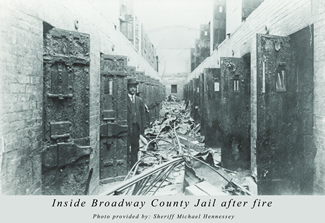
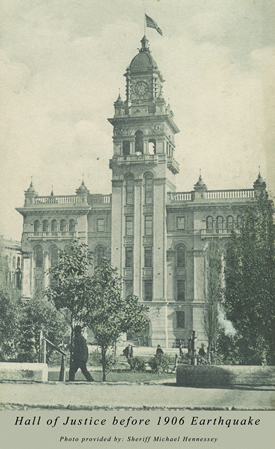 Guardsman Enewold exaggerated the number of prisoners, but not by much. According to Sheriff O'Neil (
Guardsman Enewold exaggerated the number of prisoners, but not by much. According to Sheriff O'Neil (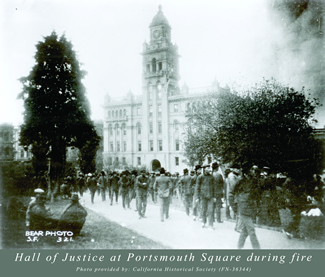
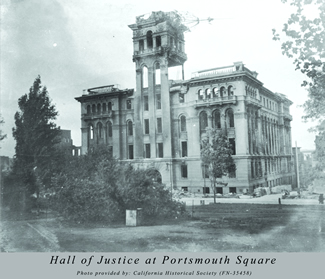
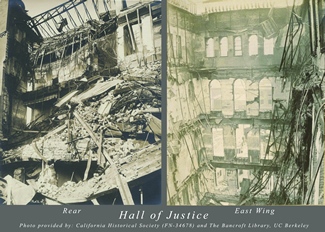
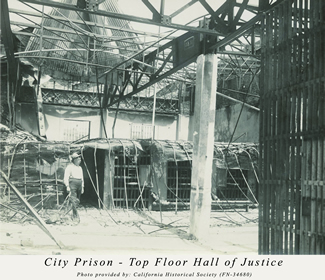
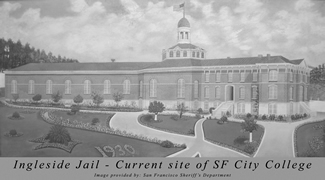
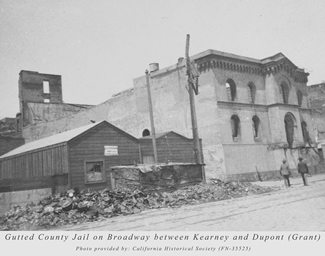
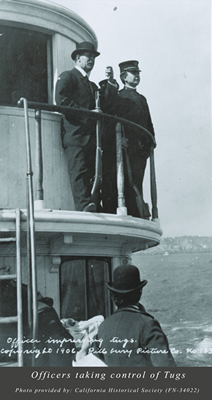
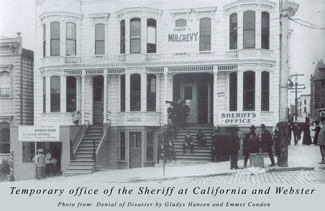 Of course, with San Francisco's new City Hall completely destroyed, Sheriff O'Neil was displaced along with his prisoners. After the earthquake, the Office of the Sheriff was located in a gymnasium on Laguna Street between Grove and Hayes Streets. (
Of course, with San Francisco's new City Hall completely destroyed, Sheriff O'Neil was displaced along with his prisoners. After the earthquake, the Office of the Sheriff was located in a gymnasium on Laguna Street between Grove and Hayes Streets. (